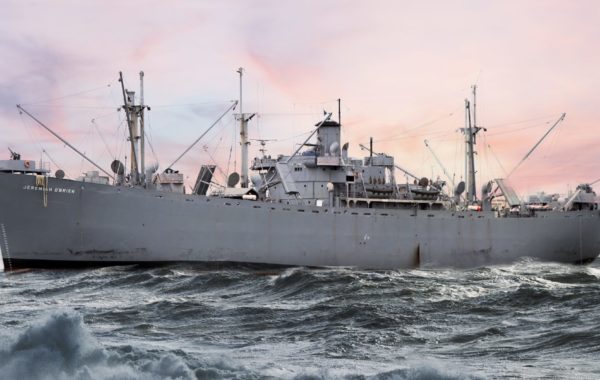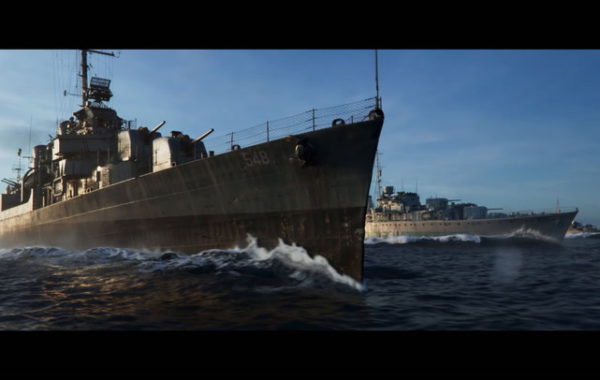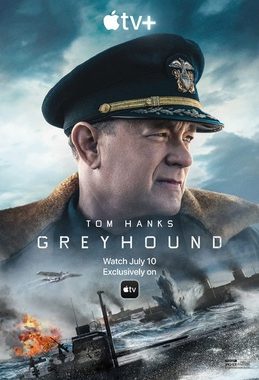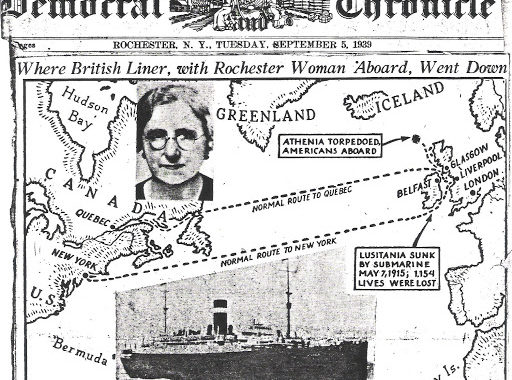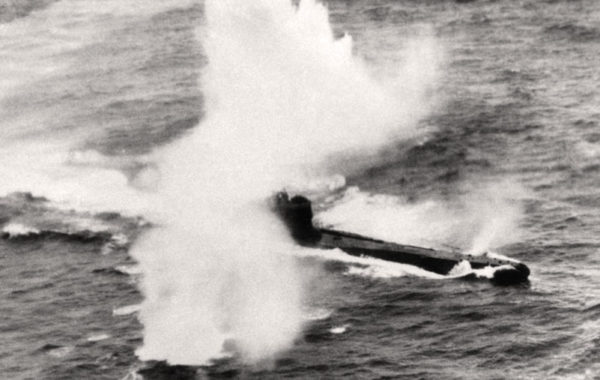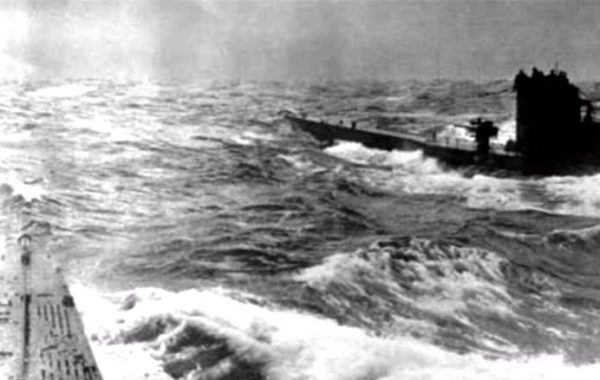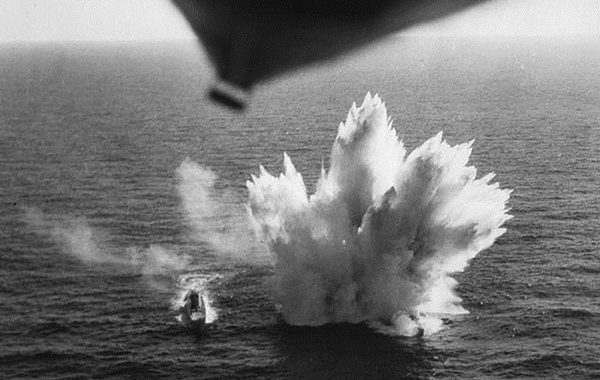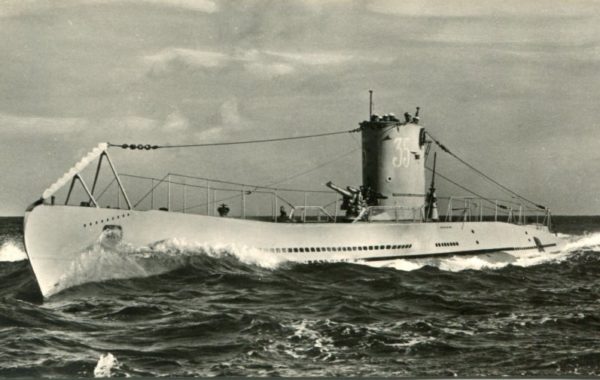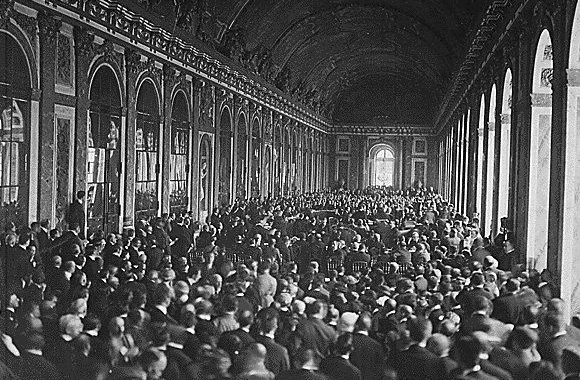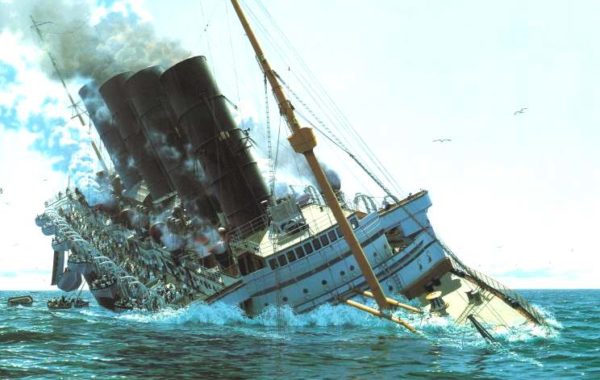A decade and a half after the Great War, the United States anxiously watched as tensions between European nations steadily mounted. War was coming again, and America needed to expand and modernize its merchant fleet in order to be prepared. The country’s fleet of freighters was aging and growing obsolete. The fleet needed more tankers and dry cargo ships.
To meet that need, Congress passed and President Roosevelt signed into law the Merchant Marine Act of 1936. The U.S. Maritime Commission, a creation of the act, laid the groundwork for expansion of the merchant fleet. By 1939, U.S. shipyards were turning out 50 ships a year. After Germany marched into Czechoslovakia, and the Maritime Commission doubled the building pace to 100 merchant ships a year, and then doubled the target again to 200 per year.
A year later, the British ordered 60 freighters from American shipyards to replace its merchant ships being sunk by German U-boats as the Battle of the Atlantic roared to life. The British design was based on the venerable tramp steamer, with its simple and reliable steam-engine power plant. It was cheap to build and cheap to run because the British had an abundance of coal for making steam.
American shipbuilders, stimulated by the British order, created a cargo vessel that was even quicker and easier to build. The construction process saved money and time by welding together the hull’s steel plates instead of riveting them. The American ship made use of the old triple-expansion steam engine because it was more rugged, easier to service, and more simple to build than a steam-turbine engine. Because of the ship’s standardized design, its parts could be widely manufactured.
The major emphasis for U.S. shipyards had become quantity: to build as many reliable ships as possible and as quickly as possible. In February, 1941, President Roosevelt announced a new U.S. shipbuilding program that would make use of mass production techniques. But, he warned, these new cargo ships would be “dreadful looking objects.”
In September, 1941, some 230 days after her keel was laid, the S.S. Patrick Henry was launched. She was the first of 2,700 U.S.-built cargo vessels known as “Liberty Ships,” and they would play a key role in the Battle of the Atlantic.
Battle of the Atlantic, Part 2
“Greyhound,” the new World War II movie starring Tom Hanks, depicts a U.S. Navy destroyer’s harrowing effort to protect a convoy of ships crossing the Atlantic Ocean from North America to the British Isles. The voyage takes place in early 1942, shortly after the United States entered the war, and at a time when German U-boats held the upper hand in the Battle of the Atlantic.
Convoys were an attempt to counter the ever-present U-boat threat to Allied merchant shipping. The threat was greatest in the mid-Atlantic “black pit,” roughly 50,000 square miles that could not be protected because of the limited range of Allied land-based aircraft.
The convoy – a grouping of merchant ships in a disciplined formation protected by a squadron of warships – was successfully employed late in World War I. Initially, merchant sea captains had been reluctant to sail in tight formations, fearful of collisions in the foggy, storm-tossed North Atlantic. Convoys, they said, would present attractive targets for U-boats, and could sail only as fast as the slowest ship, thus prolonging exposure to attack.
But as U-boats sank an increasing number of merchant ships sailing alone in World War I, the wisdom of the convoy system became apparent. While it took three years of naval warfare before Britain instituted convoys in World War I, it took the British Admiralty less than a week following Athenia’s sinking to establish the convoy system in World War II.
A convoy might consist of from 45 to 60 merchant ships, arranged in nine to twelve columns, each ship maintaining 900 yards from the ship in front of it. Each of the columns was separated by 1,000 yards. The formations could be up to four miles wide and two miles long, with the most vulnerable ships – troop carriers and tankers – in the center. A convoy was protected by ten or more escort warships, depending on availability and convoy size. As depicted in “Greyhound,” these escorts were mostly small, fast and maneuverable: typically destroyers and corvettes, the latter being a smaller, British-designed ship tailored for escort duty.
The German tactic of the “wolf pack,” a gathering of up to a dozen or more U-boats, was developed to conduct coordinated attacks on convoy formations. Wolf packs proved effective through the first half of the war, but as “Greyhound” makes clear, these sea battles always carried some risks for U-boat captains.
By mid-1943, Allied advances in detecting, locating, and attacking U-boats turned the tide in the Battle of the Atlantic. In May of that year, U-boats sank 34 merchant ships, but at a cost of 34 U-boats, a one-to-one ratio that Germany could not sustain.
Although sporadic attacks on convoys would continue through the final two years of the war, the German navy’s U-boat commander, Admiral Karl Doenitz, acknowledged Germany had lost the Battle of the Atlantic that summer of 1943.
Battle of the Atlantic, Part 1
The new Tom Hanks movie, “Greyhound,” shines a light on one of the most consequential, yet largely overlooked conflicts of World War II – the Battle of the Atlantic. It was by far the longest continuous combat action of the war, beginning on Sept. 3, 1939, and ending May 8, 1945, the same day Germany surrendered.
Scholars have called the early months of WWII the “Phony War.” England and France had pledged to defend Poland, but took no action when Germany attacked and defeated the Poles in September, 1939. Although the British and French declared war on Germany September 3, both sides avoided major combat actions on the ground or in the air for the eight months following the fall of Poland.
But there was nothing phony about the war being waged in the Atlantic Ocean during that same period. Readers of this blog know the first shot fired in the Battle of the Atlantic was the torpedo that struck the British passenger ship Athenia less than nine hours after Britain and Germany declared war.
The battle was fought over shipping tonnage. Following the fall of France in June, 1940, the British were left to fight on alone against the Nazis. An island nation, Great Britain required a million tons of food and supplies every week in order to sustain its citizens and its war effort. German naval and air forces set out to interrupt that flow of supplies, and by the end of September they had sunk nearly 40 British merchant ships.
Clearly, such losses would be unsustainable over any length of time. For this reason, British Prime Minister Winston Churchill, writing later in his history of the war, said the only thing that frightened him during the war was “the U-boat peril.”
In coming months we will explore more about the Battle of the Atlantic, from the convoy system to U-boat wolfpacks, and the back-and-forth evolution of technology and tactics as both sides sought advantage on this expansive “battleground.”.
From Page to Screen, Part 1
Note: This is the first of several occasional blogs about our documentary project, “Athenia’s Last Voyage.”
Not long after Greenleaf Books published my historical novel, Without Warning, in 2017, readers began telling me that the story would make a great movie. When my wife, Kay, and I explored the possibility with a friend’s daughter-in-law (who is in the movie business), she suggested we first make a documentary about the Athenia incident as a way to pique interest in a future feature film.
My goal all along has been to create a wider awareness of the Athenia as a way to honor the memory of my grandmother and so many others who were aboard that ship torpedoed on the first day of World War II. A documentary seemed like an easy next step toward that goal.
Kay and I have been on a steep learning curve ever since. We found a director, Meghan Courtney, eager to take on the project. Last year we filmed interviews with a dozen Athenia survivors and descendants of survivors in Florida and in Halifax, Nova Scotia, where many had come to attend an 80th anniversary commemoration of Athenia’s sinking.
When the dust finally settled, we had more than 180 pages of interview transcripts. It was time to finally write a script for our documentary, using excerpts from the interviews and narration to tell Athenia’s story. That word “story” is the key. To succeed, our script must conform to the basic rules of storytelling. It should enthrall and entertain us from the beginning, to the middle, and all the way through to the end.
We need to engage viewers immediately, with a promise that the story will be well worth the time they spend to watch it. The beginning must quickly establish the documentary’s timeframe and setting, introduce principal characters, and identify what is at stake for the characters.
The beginning is followed by an inciting incident that complicates the characters’ ability to achieve their goal. The incident introduces the middle of the story in which the characters seek again and again to overcome the obstacles that keep them from achieving their goal. This drama builds to a climax, which brings the middle to a close and introduces the ending in which the story comes to a meaningful conclusion.
Good storytellers bring these elements together in ways that seem innovative and unexpected to create memorable novels and screenplays. But these same principles apply to documentary films, with one big exception. In fiction, the storyteller can invent plot twists and characters that serve these basic elements, but a documentarian has to deal with reality. We can’t make up characters or events to suit a plot.
Laying out the bones of our story in a manner that conforms with all the tenets of dramatic storytelling is our next great challenge.
You can follow our progress at our documentary’s website:
A Brief History of Submarines, Part 8
When the United States entered World War II in December 1941, it did not take long for Hitler’s U-boats to bring the war to America’s shores. During the first eight months of 1942, U-boats sank more than 600 Allied ships off the East coast and in the Caribbean, before U.S. defenses stiffened. Partly as a consequence of this experience, when British Prime Minister Winston Churchill met with President Franklin Roosevelt in Casablanca in January, 1943, they agreed that war against the U-boats should be a top priority.
That same month, a change in command in Germany would mark the beginning of a long, slow decline in the Nazi submarine threat through the remainder of the war. Adolf Hitler promoted Karl Doenitz, the U-boat fleet commander, to Grand Admiral of the German Navy. Day-to-day command of the submarine fleet passed to Doenitz’s chief of staff, who lacked his boss’s strategic foresight and never gained the unquestioned loyalty of U-boat captains that Doenitz enjoyed.
Several developments began turning the tide of the naval war by mid-1943. The extended range of Allied aircraft meant that U-boats could no longer act with impunity in the mid-Atlantic. Airborne radar, which the Nazis did not think possible, gave Allied planes the opportunity to attack U-boats on the ocean’s surface at night. Improvements in high frequency direction-finding allowed the Allies to locate U-boats whenever they were in communications with their headquarters.
The Allied surface navies benefitted from advances in weaponry and improved tactics. The Hedgehog system fired depth charges in a circular pattern ahead of a suspected U-boat’s anticipated course. Certain charges detonated on contact, while others were time-fused so that even a near miss might explode and damage a U-boat enough to bring it to the surface.
New tactics created special convoy escort groups that began deploying in April of 1943. They consisted of up to ten anti-submarine warships operating in concert with an aircraft carrier and became known as “hunter-killer” groups. Once a U-boat was detected, using sonar, radio frequencies or aerial spotting, a number of the group’s warships would be dispatched to stay on top of the submarine until it had to come to the surface, where it was no match for the firepower of the ships that awaited it.
The hunters had become the hunted.
Following D-day and the invasion of France, the Allies lost 24 merchant ships from September through December of 1944. In that same period, Germany lost 55 U-boats.
From Sept. 3, 1939, to May 8, 1945, roughly 39,000 men took part in U-boat combat operations; 27,500 of those men never returned. U-boats accounted for about 2,700 merchant ships sunk during the war, more than one ship for every day of the war. But their success came at a high price: 87 percent of all U-boats that sailed on operational patrols were sunk or lost, and seven of every ten crew members died at sea.
A Brief History of Submarines, Part 7
After experiencing poor results early in the war, Karl Doenitz, the German U-boat fleet commander, reintroduced his “pack tactic” in the summer of 1940. It called for multiple U-boats to attack a convoy at the same time, a gathering that became known as a “wolf pack.”
The approach was simple in theory. The first U-boat to detect a convoy would alert others and shadow the formation until more U-boats could assemble for the attack. Early in the war, coordination of the attack was given to the senior U-boat commander on the scene. But this proved cumbersome and the results were disappointing.
Doenitz’s revised approach was to have his headquarters coordinate the attacks. Once a shadow boat notified headquarters of a convoy’s direction and speed, the information was relayed to the nearest U-boats. When the pack assembled (each boat reporting as it arrived on station), headquarters alerted the captains of the number of boats in the pack and give the order to attack. U-boat commanders were on their own to attack as they saw fit. The sudden free-for-all was meant to overwhelm Convoy escorts.
The success of the wolf pack was immediately apparent. From June to October 1940, U-boats sank 274 merchant ships for a total of nearly 1.4 million tons of shipping capacity. At the same time, only six U-boats were lost. The number of merchant ships sunk exceeded available replacements, a situation that, if sustained by Germany, would cut the British Isles’ lifeline. Not surprisingly, the period came to be known as “the happy time” for the U-boat fleet.
To achieve its ultimate goal, the wolf pack tactic required construction of many more U-boats and relied on the coded messaging between fleet headquarters and boats at sea provided by the supposedly unbreakable Enigma encryption device.
To answer the first need, U-boat construction was ramping up. By the end of 1941, Doenitz would have 91 operational U-boats. That year, they managed to sink 432 ships amounting to more than two million tons of capacity lost. The number of available U-boats would more than double in 1942, but the tonnage of ships sunk did not keep pace.
The ratio of merchant shipping losses did not continue to grow as the number of U-boats increased, because of several factors. The supposedly unbreakable Enigma device was compromised in mid-1941. British intelligence operatives received a huge boost in breaking the code when the Royal Navy captured an Enigma machine and vital code books from a sinking U-boat. (See blog “Enigma’s Mysteries Revealed,” Oct. 2, 2018.) At the same time, British convoy escorts were devising new, more effective counter measures to deal with wolf packs. And in December of 1941 the United States entered the war following the Japanese attack on Pearl Harbor.
We’ll have more about these developments in our next blog.
A Brief History of Submarines, Part 6
In the first few months of World War II, Germany’s U-boats were tasked with blockading British ports. In carrying out this assignment, U-boat fleet commander Karl Doenitz faced two challenges. The first was a limited number of submarines – only 21 ocean-going boats were available – and the second was their vulnerability to land-based British airpower.
To meet the first challenge, production of Type VII U-boats became a priority in the fall of 1939. The boats were small and took less time to build than larger surface ships. Within a year, German industry developed a system of prefabricating U-boat parts in different locations, which sped up production. Even so, it would take more than a year to begin supplying Doenitz with the number of Type-VII’s he wanted.
To meet the second challenge, Doenitz shifted U-boat operations to the mid-Atlantic, beyond the reach of land-based aircraft.
Working in this “killing zone,” U-boats sank 300,000 tons of allied shipping during the first four months of 1940. But this success came at a grim price: 13 U-boats sunk from January through April.
British convoys, escorted by warships, made merchant shipping difficult for U-boats to attack. The Royal Navy escorts employed radar and an underwater sonic detection system known as ASDIC, to locate German submarines. The more audacious U-boat captains responded by attacking at night, surfacing their boats inside convoy formations. ASDIC could not locate a boat on the surface, and attacking from within the convoy neutralized radar detection because a U-boat was largely indistinguishable on radar screens from the ships it was attacking.
When France fell to Germany in the summer of 1940, Doenitz gained access to ports on the Bay of Biscay. This allowed his U-boats to reach the mid-Atlantic more quickly and stay on station for longer periods.
Up until this point in the war, U-boats had been operating largely on their own. Each boat patrolled a specific area, attacking merchant ships and convoys when they were detected in its combat zone. But this approach was about to change in a way that would dramatically alter the course of the war.
More in our next blog.
A Brief History of Submarines, Part 5
In 1938, German Chancellor Adolf Hitler approved a grand blueprint for building a German navy capable of challenging Great Britain’s dominance of the high seas. The ambitious “Plan Z” was due to be completed in 1948, but it had to be abandoned when Hitler invaded Poland on Sept. 1, 1939.
The German U-boat fleet commander, Karl Doenitz, had hoped to have some 300 attack submarines before going to war with the British. Instead, he had a fleet of 65 boats, only 21 of which were ocean-going attack U-boats. The design of these boats had been distilled from World War I submarines and reworked in secret by German engineers in the Netherlands.
The result was an agile, 600-ton U-boat, known as the Type VII. Its twin diesel engines could push the boat to a maximum speed of 17 knots while on the surface, but when the boat was submerged, its two battery-powered electric motors could make only half that speed. The boat was armed with four torpedo tubes in the bow and one in the stern. Including reloads, these initial U-boats carried 11 torpedoes. An 88-millimeter (mm) cannon was mounted on the deck in front of the boat’s conning tower, and a 20mm anti-aircraft gun was typically located on the deck behind the tower or, later, on the rear of the conning tower bridge itself. The submarine had become a formidable weapon of war.
The initial design, a Type VIIA, could operate underwater for about 48 hours before having to surface to recharge the batteries and provide welcome fresh air for the 40-man crew. As a result, U-boats, despite their name, spent most of their time on the ocean’s surface. By the end of the war Germany would build more than 1,100 U-boats, 709 of which were Type VII variants.
When England declared war on Germany, Sept. 3, 1939, Doenitz had already dispatched 19 U-boats in his ocean-going fleet to stations north and south of the sea lanes into the British Isles. The primary target for Germany’s navy was merchant shipping, as the Nazis sought to deny the raw materials and food supplies so vital to the British economy. U-boats sank several merchant ships, including a passenger liner, during the first days of the war. The damage prompted the British Admiralty to quickly adopt the convoy system it had employed in the previous war.
In the lead-up to World War II, Germany had focused most of its naval resources on “capital ships,” the battleships and heavy cruisers by which modern navies measured their prestige. Within a year, however, most of Germany’s capital ships had been neutralized by the larger British Royal Navy. This left the U-boat as the Nazi’s principal naval weapon, and it would prove more than equal to the task, as we will see in our next blog.
A Brief History of Submarines, Part 4
Following the armistice in November, 1918, that ended World War I, the victorious powers – England, France, America, Italy, and Japan – met in Paris beginning in January, 1919, to determine the fate of the losers. The Treaty of Versailles, signed in June, saddled Germany with crippling reparations, loss of territory, and stifling limitations on its military forces.
One of the treaty’s more contested negotiations involved the fate of submarines. The U-boat tactic of unrestricted warfare against merchant shipping led some delegates to call for a ban on all submarines as weapons of war. This drastic step was eventually deemed unnecessary because future submarine tactics could be limited through restrictive naval treaties.
The issue was academic for Germany, which was prohibited from having any submarines by the Versailles Treaty. It also required Germany to surrender all its U-boats, including those under construction, thus giving the allied navies a valuable insight into German submarine technology.
In subsequent years, the treaty’s harsh conditions created sympathy within some allied nations for the hardships it imposed on the German people, particularly as the Great Depression struck Europe in the early 1930s. Consequently, many turned a blind eye as Germany began to build up its military forces. Beginning in 1933, under the newly elected Nazi regime, Germany openly began building a few new U-boats in violation of the treaty, launching the first of these new boats in April, 1935. They were nearly identical to one of the most successful U-boat designs from World War I, a stark example of how 15 years of prohibited submarine operations had stunted German U-boat design and technology.
Unwilling to challenge Germany over its violation of the Versailles Treaty’s restrictions, England entered into a new Anglo-German Pact in 1935, in which Germany agreed to limit the size of its navy to 35 percent of the overall size of the Royal Navy fleet.
To address any lingering concerns about unrestricted warfare tactics by submarines, England, Germany and 33 other nations signed the London Submarine Protocol of 1936. The protocol affirmed earlier restrictions that a submarine could not attack an unarmed, unescorted merchant ship without first giving warning of its intent. This required a submarine to surface and put a boarding party on the merchant ship to inspect its cargo for contraband. If any such cargo was found that could aid an enemy’s war effort, the ship could be sunk, but not before its crew was removed to a place of safety.
The British may have believed they had capped German rearmament and contained the most menacing of U-boat tactics, but a reckoning awaited them and the world three years hence. The submarine was soon to play an expanded role in naval warfare, as we will see in our next blog.
A Brief History of Submarines, Part 3
At the beginning of World War I in July, 1914, Germany had 48 submarines, or “U-boats” (for Unterseeboot), in service or under construction. The German boats would prove more reliable and more lethal during the course of the conflict. Indeed, a German U-boat, U-21, was the first to sink a warship with a self-propelled torpedo when she attacked H.M.S. Pathfinder, Sept. 5, 1914.
In the opening months of the war, submarines, like their surface ship counterparts, observed the traditional “prize rules” with regard to merchant shipping. That is, merchant ships were stopped and captured or they were sunk once their crews were taken off the ships. But on Oct. 20, 1914, U-17 torpedoed and sank the first merchant ship of the war, the British-flagged S.S. Glitra, without observing the prize rules.
By February of 1915, Germany’s Kaiser Wilhelm II declared the waters around the British Isles to be a “war Zone” in which any ship could be attacked without warning, setting the stage for one of the war’s most dramatic events. On May 7, 1915, U-20 sank R.M.S. Lusitania off the Irish coast, killing nearly 1,200 passengers and crew, including 128 Americans.
The shocking deaths of so many civilians stunned the world. The United States, at the time a neutral country in the war, threatened to sever all ties with Germany. The threat prompted Germany to reinstate the prize rules in full and order seemed to have been restored. U-boat tactics involved surfacing to surprise a merchant vessel, advising its crew to abandon ship, then using the U-boat’s deck gun to sink the ship. Torpedoes were expensive and less reliable than surface fire so they were used sparingly.
A year later, at the end of May, 1916, the German and British fleets clashed in the Battle of Jutland. Although Germany claimed victory, the Royal Navy remained firmly in control of the seas. As a result, German naval high command argued to abandon the prize rules and resume attacking merchant shipping. They gambled that a high rate of merchant shipping losses would force Britain to sue for peace before the U.S. could effectively enter the war.
By the end of January, 1917, Germany announced its U-boats would henceforth conduct unrestricted warfare against all shipping. In mid-March, Germany sank three American merchant ships. The U.S. declared war on Germany April 4. The German tactics were initially effective, but the introduction of the convoy system later in the year reduced the U-boats’ success rate and in the end, Germany failed to sink enough Allied shipping to gain victory or even a stalemate.
In the final counting, Germany built 373 U-boats during the war and lost 178 to Allied action. But U-boats sank more than 30 warships and 5,000 merchant and fishing vessels, killing 15,000 sailors and civilians. In the minds of many merchant seamen the submarine had become a weapon of terror, and many negotiators at Versailles pushed to outlaw the submarine altogether.
In our next blog we will look at how the submarine navigated the interwar period.


